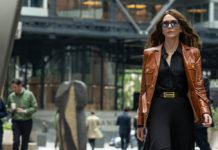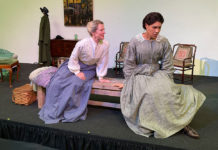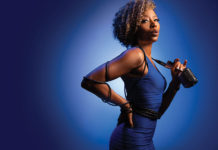Roger Ebert, RIP
Those of you familiar with my film columns in-print, on-air, and on-line may not know that the “tell it like it is” style I use comes directly from advice I received from Roger Ebert. I had already been writing my Screenings column for several years when I was introduced to Roger at a book festival in Los Angeles. I explained I was a fellow film columnist and had read his latest movie yearbook from cover to cover before I penned my first column (which was about the Australian film Muriel’s Wedding).
I recall Roger looked at my name badge carefully before replying: “You know Gil,” he said. “You can only write about what you see and hear onscreen—but what you see is influenced by everything else you have ever seen and read and heard and felt. If you can share that unique perspective on the page—share what you see and hear through your own set of experiences, then you can provide your readers with a valuable point-of-view. That’s what I try to do, and what people tell me encourages them or even angers them sometimes. It is what Gene [Siskel] does as well, and it is why we respect each other’s opinions about a particular film—even when we think the other one is completely wrong.”
In his “Ten Best Films of All Time” list, Roger shares what he sees and hears through his own set of experiences.
#1: Aguirre, Wrath of God (1972), directed by Werner Herzog: “It tells the story of the doomed expedition of the conquistador Gonzalo Pizarro, who in 1560 and 1561 led a body of men into the Peruvian rain forest, lured by stories of the lost city of gold … What Herzog sees in the story, I think, is what he finds in many of his films: Men haunted by a vision of great achievement, who commit the sin of pride by daring to reach for it, and are crushed by an implacable universe.”
#2: Apocalypse Now (1979) directed by Francis Ford Coppola: “At a distance of 20 years, Apocalypse Now is more clearly than ever one of the key films of the century. Most films are lucky to contain a single great sequence. Apocalypse Now strings together one after another, with the river journey as the connecting link.”
#3: Citizen Kane (1941) directed by Orson Welles: “Citizen Kane likes playful paradoxes…Its surface is as much fun as any movie ever made. Its depths surpass understanding. I have analyzed it a shot at a time with more than 30 groups, and together we have seen, I believe, pretty much everything that is there on the screen. The more clearly I can see its physical manifestation, the more I am stirred by its mystery.”
#4: La Dolce Vita (1960) directed by Federico Fellini: “Movies do not change, but their viewers do. When I saw La Dolce Vita in 1960, I was an adolescent for whom ‘the sweet life’ represented everything I dreamed of: sin, exotic European glamour, the weary romance of the cynical newspaperman. When I saw it again, around 1970, I was living in a version of Marcello’s world; Chicago’s North Avenue was not the Via Veneto, but at 3 a.m. the denizens were just as colorful, and I was about Marcello’s age. When I saw the movie around 1980, Marcello was the same age, but I was 10 years older, had stopped drinking, and saw him not as a role model but as a victim, condemned to an endless search for happiness that could never be found, not that way … and when I saw the movie right after Mastroianni died, I thought that Fellini and Marcello had taken a moment of discovery and made it immortal. There may be no such thing as the sweet life. But it is necessary to find that out for yourself.”
#5: The General (1927) directed by Buster Keaton: “Today I look at Keaton’s works more often than any other silent films. They have such a graceful perfection, such a meshing of story, character and episode, that they unfold like music. Although they’re filled with gags, you can rarely catch Keaton writing a scene around a gag; instead, the laughs emerge from the situation.”
#6: Raging Bull (1980) directed by Martin Scorsese: “Raging Bull is the most painful and heartrending portrait of jealousy in the cinema — an Othello for our times. It’s the best film I’ve seen about the low self-esteem, sexual inadequacy and fear that lead some men to abuse women. Boxing is the arena, not the subject.”
#7: Tokyo Story (1953) directed by Yasujiro Ozu: “With Ozu, it’s as if the characters are living their lives unaware that a movie is being shot. And so we get to know them gradually, begin to look for personal characteristics and to understand the implications of little gestures and quiet remarks.”
#8: The Tree of Life (2011) directed by Terrence Malick: “I don’t know when a film has connected more immediately with my own personal experience. In uncanny ways, the central events of The Tree of Life reflect a time and place I lived in, and the boys in it are me. If I set out to make an autobiographical film, and if I had Malick’s gift, it would look so much like this.”
#9: 2001: A Space Odyssey (1968) directed by Stanley Kubrick: “The genius is not in how much Stanley Kubrick does in 2001: A Space Odyssey, but in how little. This is the work of an artist so sublimely confident that he doesn’t include a single shot simply to keep our attention. He reduces each scene to its essence, and leaves it on screen long enough for us to contemplate it, to inhabit it in our imaginations. Alone among science-fiction movies, ‘2001’ is not concerned with thrilling us, but with inspiring our awe.”
#10: Vertigo (1958) directed by Alfred Hitchcock: “Vertigo is about how Hitchcock used, feared and tried to control women. He is represented by Scottie (James Stewart), a man with physical and mental weaknesses (back problems, fear of heights), who falls obsessively in love with the image of a woman — and not any woman, but the quintessential Hitchcock woman. When he cannot have her, he finds another woman and tries to mold her, dress her, train her, change her makeup and her hair, until she looks like the woman he desires.”
Comments? E-mail gi*********@co*****.net.
61.6
F
Healdsburg
April 14, 2025







